engine JAGUAR S TYPE 2005 1.G Technical Guide Update
[x] Cancel search | Manufacturer: JAGUAR, Model Year: 2005, Model line: S TYPE, Model: JAGUAR S TYPE 2005 1.GPages: 133, PDF Size: 3.48 MB
Page 46 of 133
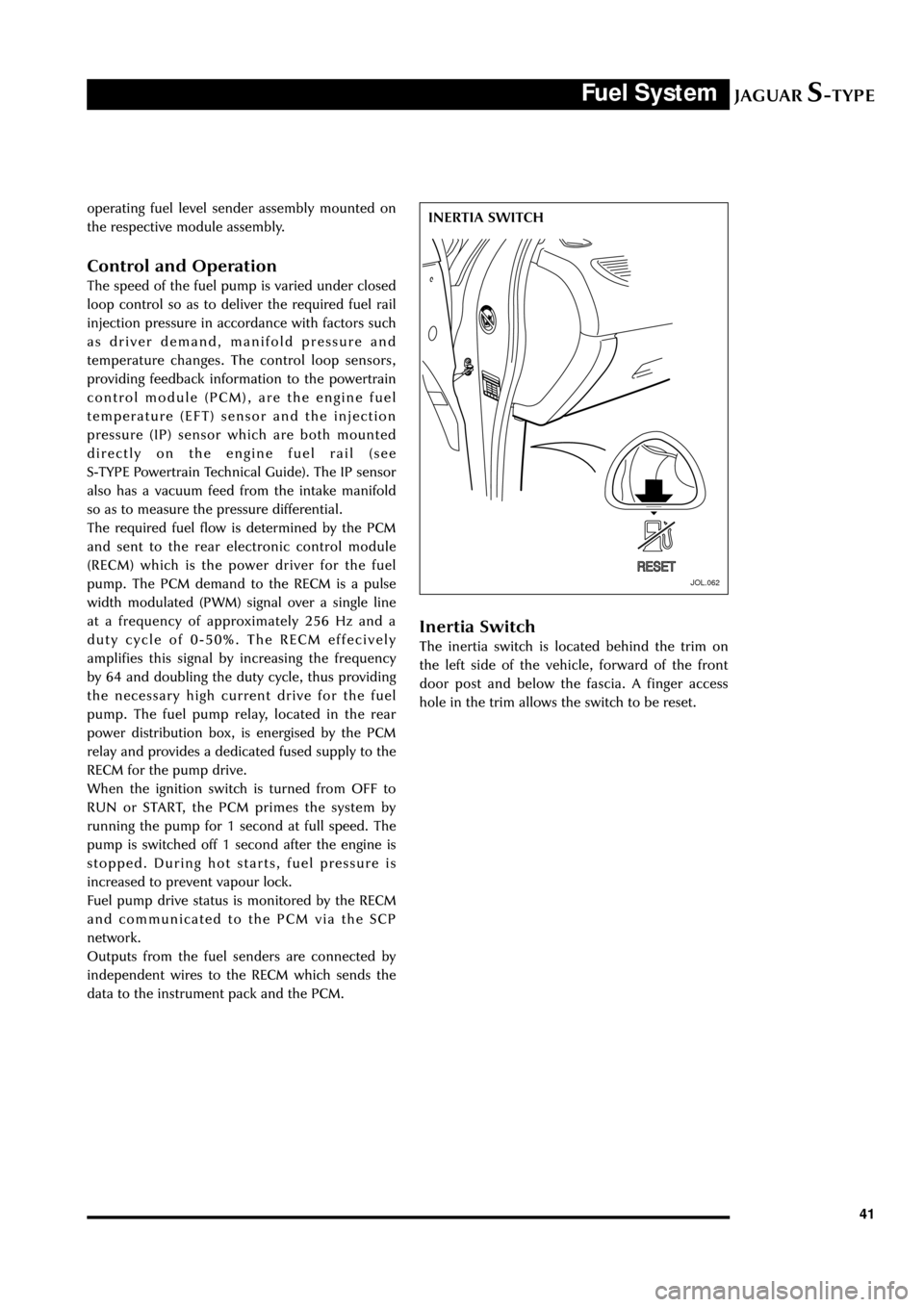
JAGUARS-TYPEFuel System
41
JOL.062
INERTIA SWITCH operating fuel level sender assembly mounted on
the respective module assembly.
Control and Operation
The speed of the fuel pump is varied under closed
loop control so as to deliver the required fuel rail
injection pressure in accordance with factors such
as driver demand, manifold pressure and
temperature changes. The control loop sensors,
providing feedback information to the powertrain
control module (PCM), are the engine fuel
temperature (EFT) sensor and the injection
pressure (IP) sensor which are both mounted
directly on the engine fuel rail (see
S-TYPE Powertrain Technical Guide). The IP sensor
also has a vacuum feed from the intake manifold
so as to measure the pressure differential.
The required fuel flow is determined by the PCM
and sent to the rear electronic control module
(RECM) which is the power driver for the fuel
pump. The PCM demand to the RECM is a pulse
width modulated (PWM) signal over a single line
at a frequency of approximately 256 Hz and a
duty cycle of 0-50%. The RECM effecively
amplifies this signal by increasing the frequency
by 64 and doubling the duty cycle, thus providing
the necessary high current drive for the fuel
pump. The fuel pump relay, located in the rear
power distribution box, is energised by the PCM
relay and provides a dedicated fused supply to the
RECM for the pump drive.
When the ignition switch is turned from OFF to
RUN or START, the PCM primes the system by
running the pump for 1 second at full speed. The
pump is switched off 1 second after the engine is
stopped. During hot starts, fuel pressure is
increased to prevent vapour lock.
Fuel pump drive status is monitored by the RECM
and communicated to the PCM via the SCP
network.
Outputs from the fuel senders are connected by
independent wires to the RECM which sends the
data to the instrument pack and the PCM.
Inertia Switch
The inertia switch is located behind the trim on
the left side of the vehicle, forward of the front
door post and below the fascia. A finger access
hole in the trim allows the switch to be reset.
Page 47 of 133
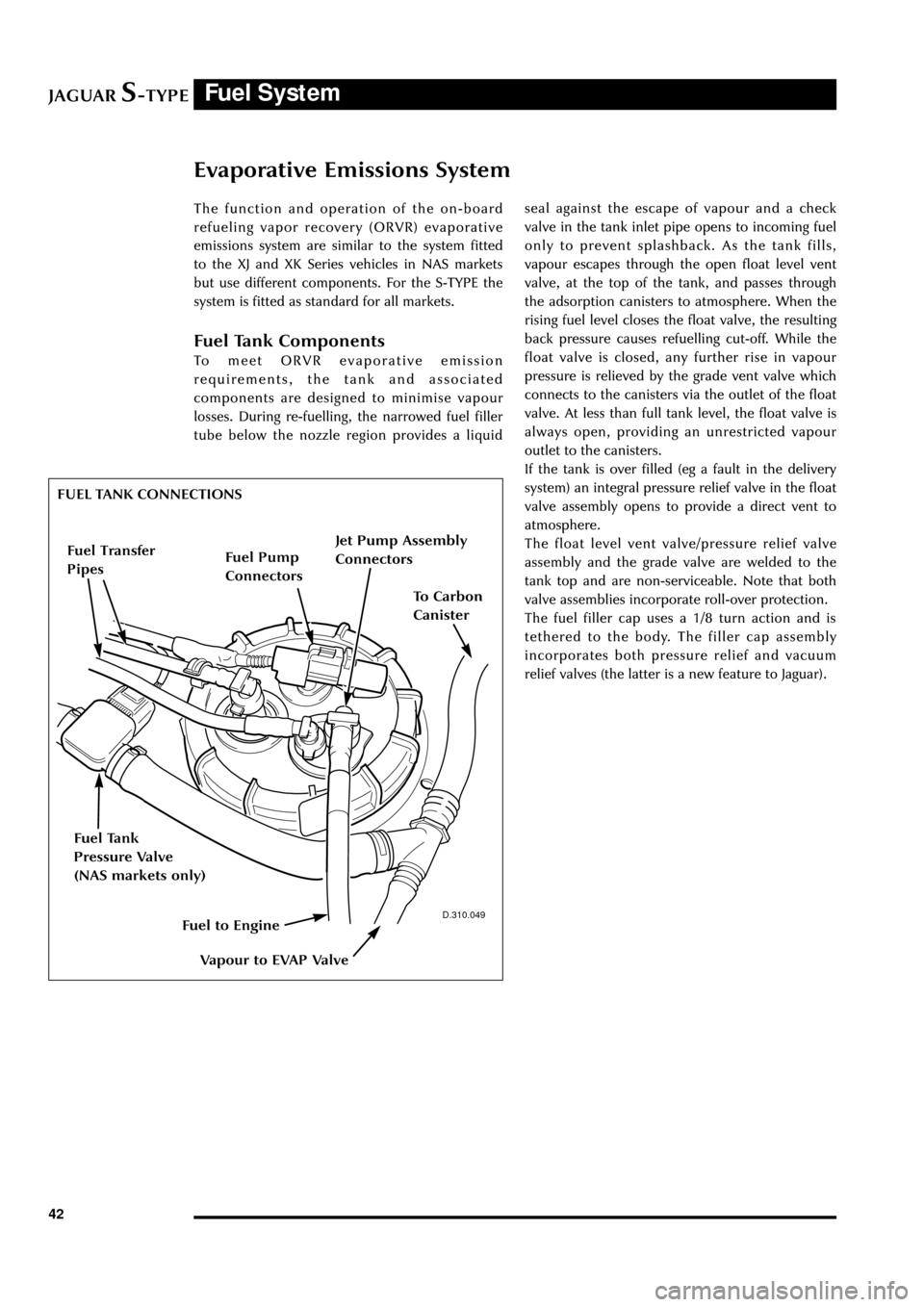
JAGUARS-TYPEFuel System
42
Evaporative Emissions System
The function and operation of the on-board
refueling vapor recovery (ORVR) evaporative
emissions system are similar to the system fitted
to the XJ and XK Series vehicles in NAS markets
but use different components. For the S-TYPE the
system is fitted as standard for all markets.
Fuel Tank Components
To meet ORVR evaporative emission
requirements, the tank and associated
components are designed to minimise vapour
losses. During re-fuelling, the narrowed fuel filler
tube below the nozzle region provides a liquidseal against the escape of vapour and a check
valve in the tank inlet pipe opens to incoming fuel
only to prevent splashback. As the tank fills,
vapour escapes through the open float level vent
valve, at the top of the tank, and passes through
the adsorption canisters to atmosphere. When the
rising fuel level closes the float valve, the resulting
back pressure causes refuelling cut-off. While the
float valve is closed, any further rise in vapour
pressure is relieved by the grade vent valve which
connects to the canisters via the outlet of the float
valve. At less than full tank level, the float valve is
always open, providing an unrestricted vapour
outlet to the canisters.
If the tank is over filled (eg a fault in the delivery
system) an integral pressure relief valve in the float
valve assembly opens to provide a direct vent to
atmosphere.
The float level vent valve/pressure relief valve
assembly and the grade valve are welded to the
tank top and are non-serviceable. Note that both
valve assemblies incorporate roll-over protection.
The fuel filler cap uses a 1/8 turn action and is
tethered to the body. The filler cap assembly
incorporates both pressure relief and vacuum
relief valves (the latter is a new feature to Jaguar).
D.310.049
FUEL TANK CONNECTIONS
Fuel Tank
Pressure Valve
(NAS markets only)
Jet Pump Assembly
Connectors
Fuel Pump
Connectors
To Carbon
Canister
Vapour to EVAP Valve
Fuel to Engine
Fuel Transfer
Pipes
Page 48 of 133
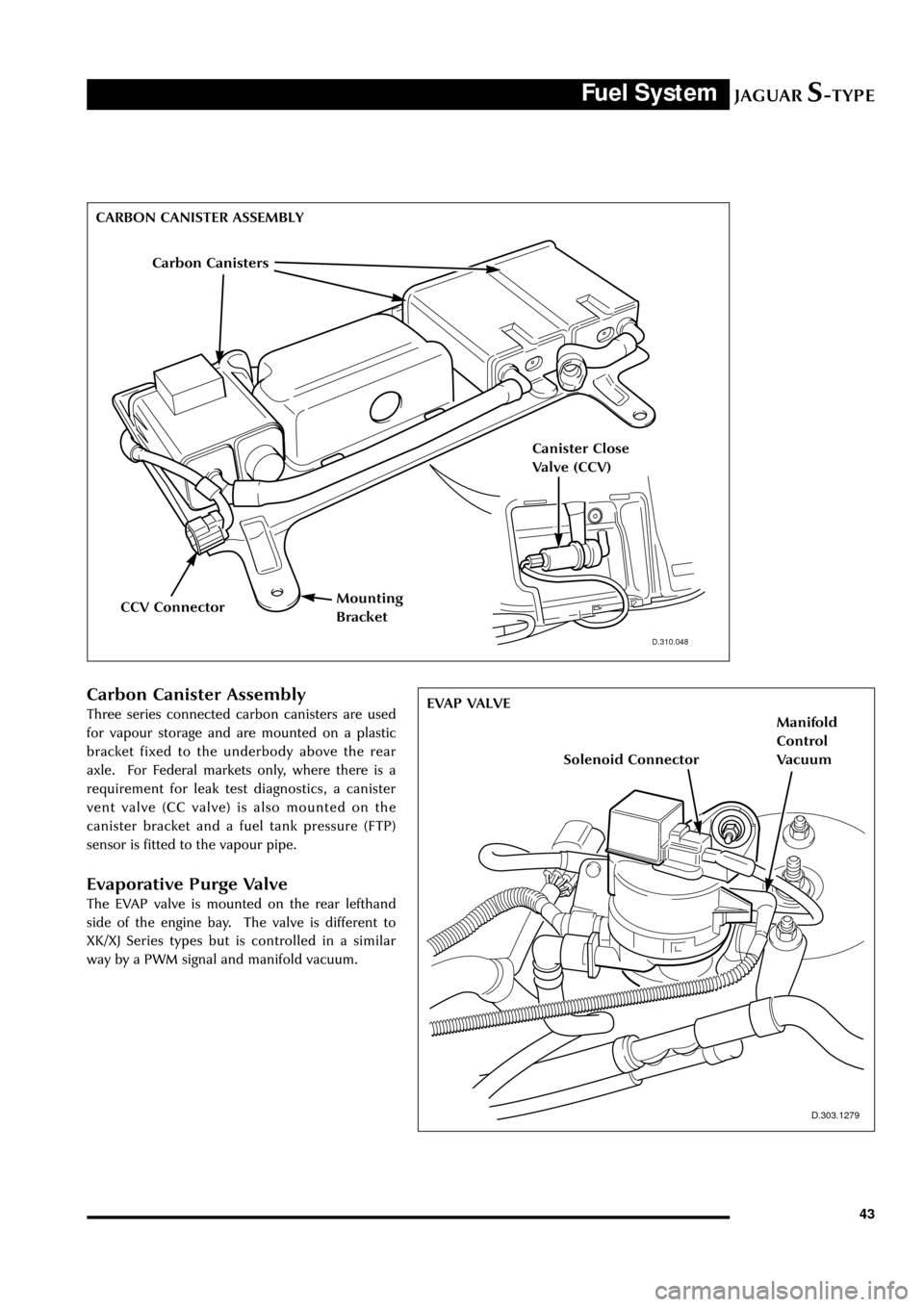
JAGUARS-TYPEFuel System
43
Carbon Canister Assembly
Three series connected carbon canisters are used
for vapour storage and are mounted on a plastic
bracket fixed to the underbody above the rear
axle. For Federal markets only, where there is a
requirement for leak test diagnostics, a canister
vent valve (CC valve) is also mounted on the
canister bracket and a fuel tank pressure (FTP)
sensor is fitted to the vapour pipe.
Evaporative Purge Valve
The EVAP valve is mounted on the rear lefthand
side of the engine bay. The valve is different to
XK/XJ Series types but is controlled in a similar
way by a PWM signal and manifold vacuum.
D.310.048
D.303.1279
EVAP VALVE CARBON CANISTER ASSEMBLY
Carbon Canisters
CCV Connector
Canister Close
Valve (CCV)
Mounting
Bracket
Solenoid Connector
Manifold
Control
Vacuum
Page 49 of 133
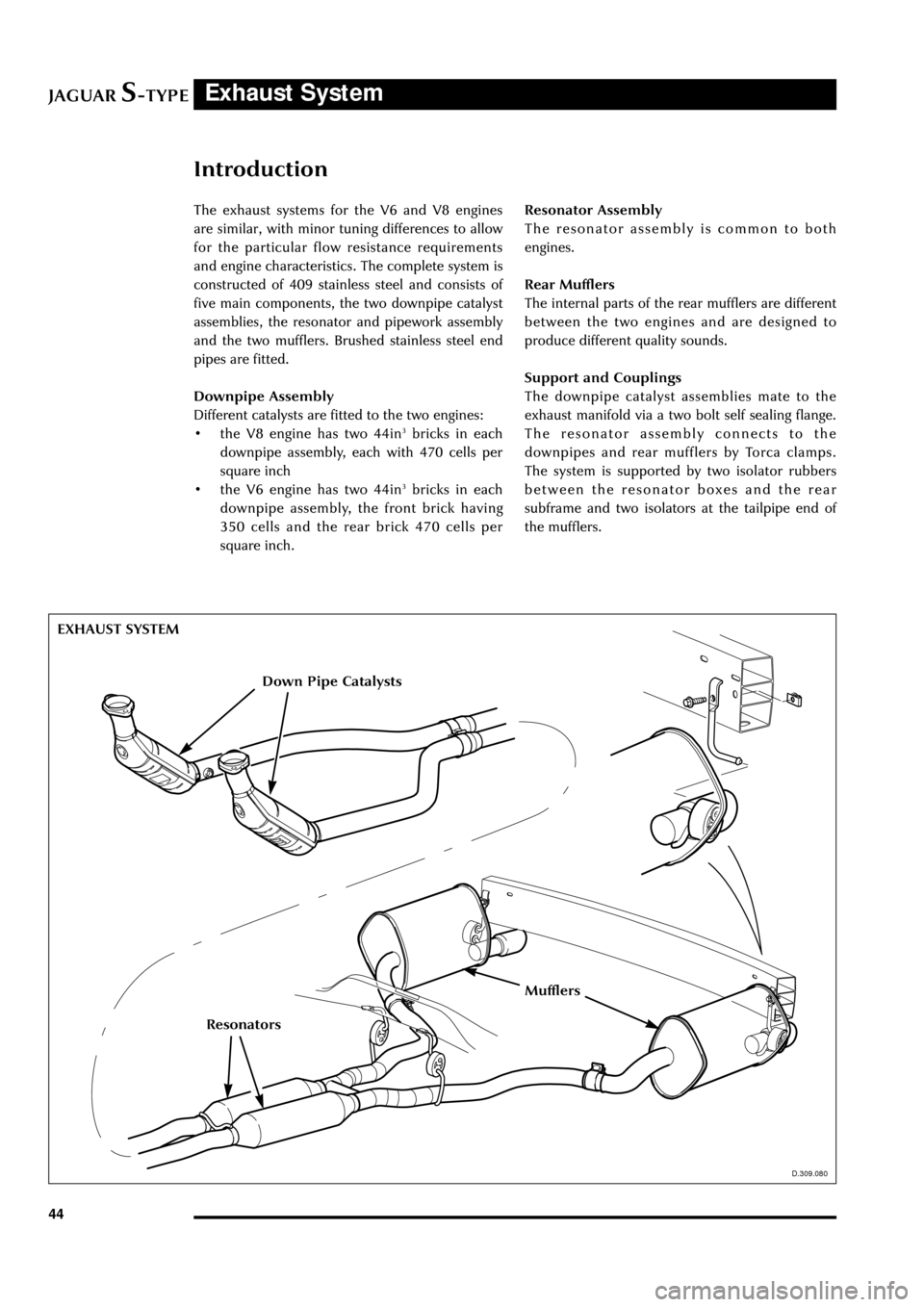
JAGUARS-TYPEExhaust System
44
Introduction
D.309.080
The exhaust systems for the V6 and V8 engines
are similar, with minor tuning differences to allow
for the particular flow resistance requirements
and engine characteristics. The complete system is
constructed of 409 stainless steel and consists of
five main components, the two downpipe catalyst
assemblies, the resonator and pipework assembly
and the two mufflers. Brushed stainless steel end
pipes are fitted.
Downpipe Assembly
Different catalysts are fitted to the two engines:
¥ the V8 engine has two 44in
3bricks in each
downpipe assembly, each with 470 cells per
square inch
¥ the V6 engine has two 44in
3bricks in each
downpipe assembly, the front brick having
350 cells and the rear brick 470 cells per
square inch.Resonator Assembly
The resonator assembly is common to both
engines.
Rear Mufflers
The internal parts of the rear mufflers are different
between the two engines and are designed to
produce different quality sounds.
Support and Couplings
The downpipe catalyst assemblies mate to the
exhaust manifold via a two bolt self sealing flange.
The resonator assembly connects to the
downpipes and rear mufflers by Torca clamps.
The system is supported by two isolator rubbers
between the resonator boxes and the rear
subframe and two isolators at the tailpipe end of
the mufflers.
EXHAUST SYSTEM
D.309.080
Down Pipe Catalysts
Resonators
Mufflers
Page 52 of 133
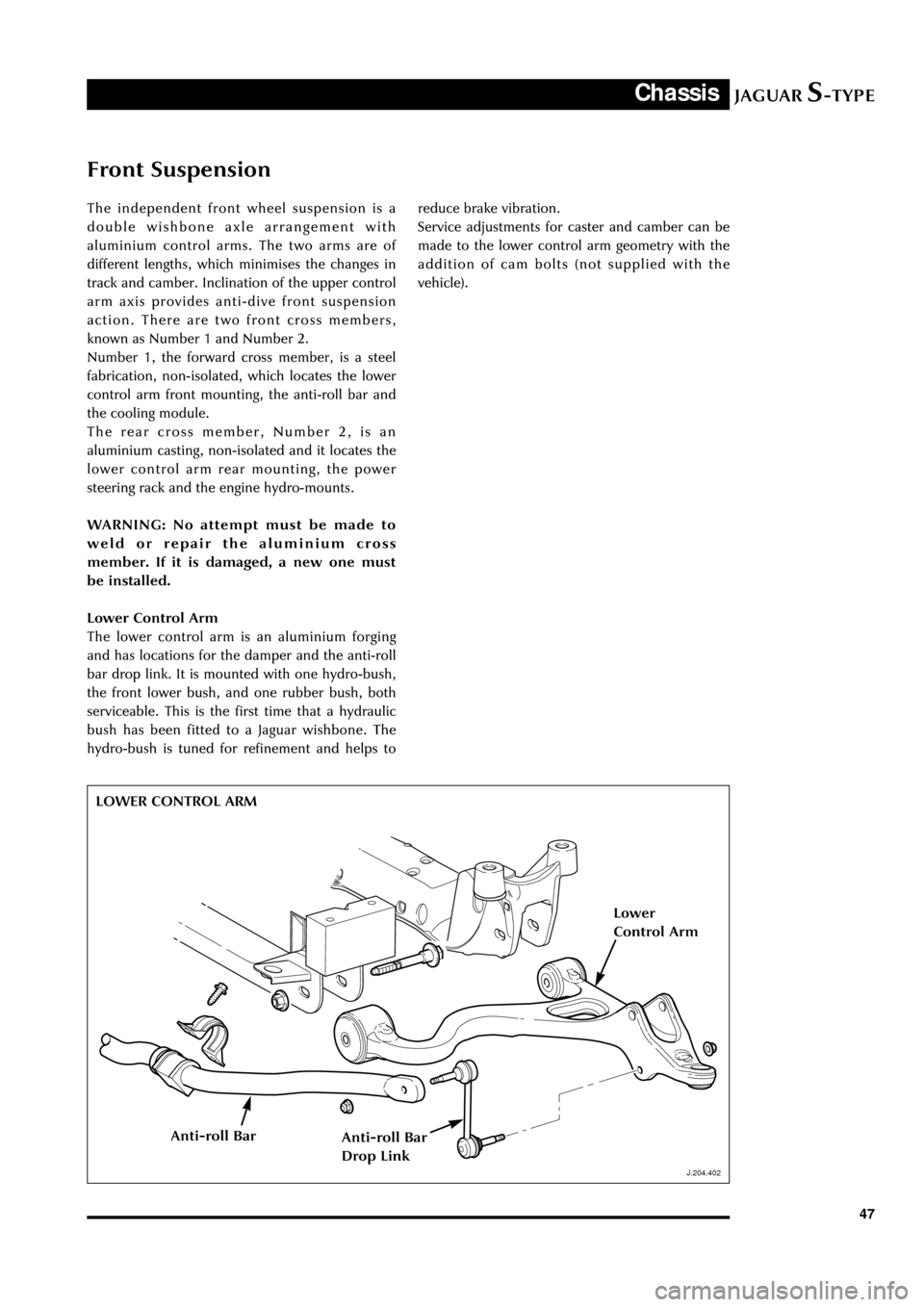
JAGUARS-TYPEChassis
47
Front Suspension
The independent front wheel suspension is a
double wishbone axle arrangement with
aluminium control arms. The two arms are of
different lengths, which minimises the changes in
track and camber. Inclination of the upper control
arm axis provides anti-dive front suspension
action. There are two front cross members,
known as Number 1 and Number 2.
Number 1, the forward cross member, is a steel
fabrication, non-isolated, which locates the lower
control arm front mounting, the anti-roll bar and
the cooling module.
The rear cross member, Number 2, is an
aluminium casting, non-isolated and it locates the
lower control arm rear mounting, the power
steering rack and the engine hydro-mounts.
WARNING: No attempt must be made to
weld or repair the aluminium cross
member. If it is damaged, a new one must
be installed.
Lower Control Arm
The lower control arm is an aluminium forging
and has locations for the damper and the anti-roll
bar drop link. It is mounted with one hydro-bush,
the front lower bush, and one rubber bush, both
serviceable. This is the first time that a hydraulic
bush has been fitted to a Jaguar wishbone. The
hydro-bush is tuned for refinement and helps to
J.204.402
reduce brake vibration.
Service adjustments for caster and camber can be
made to the lower control arm geometry with the
addition of cam bolts (not supplied with the
vehicle).
LOWER CONTROL ARM
J.204.402
Lower
Control Arm
Anti-roll BarAnti-roll Bar
Drop Link
Page 55 of 133

JAGUARS-TYPEChassis
50
D.204.399
FRONT SPRING AND DAMPER
D.204.399
Wheel Alignment
Camber caster and toe are adjustable on the front
suspension only. Toe is the only adjustment on the
rear suspension. Camber and caster are adjusted
by means of eccentric cams on the lower control
arm mounting bolts. The front toe is adjusted by
use of the front tie rod. The rear toe is adjusted by
the use of toe link assemblies connecting the
knuckles to the rear sub-frame.
Anti-roll Bars
There are two types of front anti-roll bars, one for
all V6 and base V8 engined vehicles and one for
V8 sport. There are two types of rear anti-roll
bars, one for all V6 and base V8 engined vehicles
and one for V8 sport.
All anti-roll bars are similar to current saloon
except that the front bushes have moulded insert
for tuning.
Springs and Dampers
There are numerous variants to suit both
ÔstandardÕ and ÔsportÕ derivatives of the V6 and V8
engined vehicles. Both front and rear springs and
dampers are similar to current sports vehicles.
With a strut type assembly, integrated top mount
and two-position lower spring pan. The front and
rear co-axial strut and spring assemblies are
installed between the lower control arms and the
vehicle body.
Sports dampers are CATS only, as XK series.
The CATS suspension is similar to the system
introduced on the XK8. It is a two-stage adaptive
damping ride control. The control module is
located in the rear left-hand corner of the spare
wheel well. Three accelerometers are fitted. The
front vertical and lateral accelerometers are
mounted as an assembly to the vapour
management valve bracket. The lateral
D.204.401
the A-frame bush on current sports and saloon
vehicles. The bushes are not bonded in place but
require a special lubricant when assembling. Care
must be taken to ensure that the replacement
bushes are pushed fully home, the angular
orientation of the bushes is important and it is
essential to mark the position of the subframe
before removing from the vehicle or else driveline
alignment will be lost.
REAR SPRING AND DAMPER
D.204.401
Page 58 of 133

JAGUARS-TYPEChassis
53
Driveline
Introduction
The driveline is a standard type with the engine
position at the front and driven rear axle. This will
be the first time that Jaguar has used in-plant
driveline balancing to improve noise, vibration
and handling. The driveline is finely balanced at
the rear driveshaft joint. The centre bearing is
laser aligned during initial factory build.
The alloy rear engine mountings have two
variants, one for automatic transmission and one
for manual transmission. They are both
serviceable items. The V6 auto is the same as the
V8 but rotated in plan by 180 degrees. The rubber
mountings are carry over concept from the
current XJ and XK Series vehicles but are not
D.307.322
DRIVELINE ARRANGEMENTinterchangeable with them. Both automatic
transmission rubber mountings are common but
with a softer unique mount for the manual V6
transmission.
In service if they are replaced, ensure that there
are buffer gaps and that they are approximately
equal. Neither will be contaminated by lubricant
or automatic transmission fluid.
Driveshaft
The S-TYPE has a two-piece welded steel tube
driveshaft with a splined centre slip joint and
locking collar, the whole being aligned with the
body centreline. The driveshaft has rubber flex
couplings and a rubber, body-mounted, centre
bearing. For safety, the front tube is collapsible.
Page 62 of 133

JAGUARS-TYPEChassis
57
D.206.176
BRAKE BOOSTER Brake Booster
The brake booster is a Lucas unit mounted on the
engine bay bulkhead with a 25.4mm diameter
master cylinder and integral brake fluid reservoir.
NOTE: The reservoir is also a combined
brake/clutch reservoir for manual transmission
vehicles.
Twin vacuum boosters of 8 inch and 9 inch sizes
are fitted.
The DSC booster is different having integral
pressure transducers and solenoids with air
control valves for the booster. The transducers are
located on the brake master cylinder and are used
for pressure feedback, brake application and fail
safe operation. The booster is used to supply
brake pressure without driver input.
ABS operation is no different to current Jaguar
vehicles.
Parking Brake
The parking brake lever is mounted on the RH
side of the centre console for all models, with
conventional button operation as current XJ
sedan. It is a self-adjusting system operating on
the rear brake callipers. All models have a leather
grip.
D.206.158
PARKING BRAKE
Page 63 of 133

JAGUARS-TYPEChassis
58
Power Assisted Steering
Introduction
The Jaguar S-TYPE has a variable assist rack and
pinion steering gear and variable rack ratio. The
variable steering rack ratio reduces the number of
turns from lock to lock (2.8) to enhance parking
manoeuvrability whilst maintaining the on-centre
steering precision required at high speed. Full
power assistance is provided for parking. Steering
assistance decreases smoothly at a calibrated rate
to raise driver steering efforts as vehicle speed
increases.
Servicing
There are no carry over parts from XK or XJ Series
vehicles.
The rack is mounted to the rear of cross member
Number 2. The PAS pump is belt driven. A PAS
cooler matrix is located within the radiator
package.
Low PAS pump speeds problems are prevented by
increasing engine speed. A power steering
pressure (PSP) switch senses the demand on the
pump at low engine speeds and increases the
speed to a pre-set minimum.
Hose connections to the pump and the steering
gear are quickfit connectors. The quick connect
tube must be pushed into the existing tube nut
port, along the centreline. The assembly is
complete when the tube end bottoms out in the
port with an audible click/snap. Correct assembly
should be verified by pulling the quickfit tube end.
Servicing of the PAS line involves removal of the
quickfit nut. Replacement PAS lines are supplied
complete with quickfit nut and sealing washer. If
the joint is disturbed it is compulsory to replace
the PTFE sealing ring otherwise leaks are
inevitable. Replacement sealing washers may be
installed with the use of Service tool
D90P-3517-A.
Care must be taken when removing the quickfit
nut from the V6 engine pump as the pulley is
PHENOLIC and is susceptible to damage. The V8
pump installation provides a short jumper tube
from the pump to improve accessibility to the
high-pressure hose connection. The PAS pulley
D.211.247
PA S R AC K
D.211.258
POWER STEERING PRESSURE SWITCH
Page 69 of 133
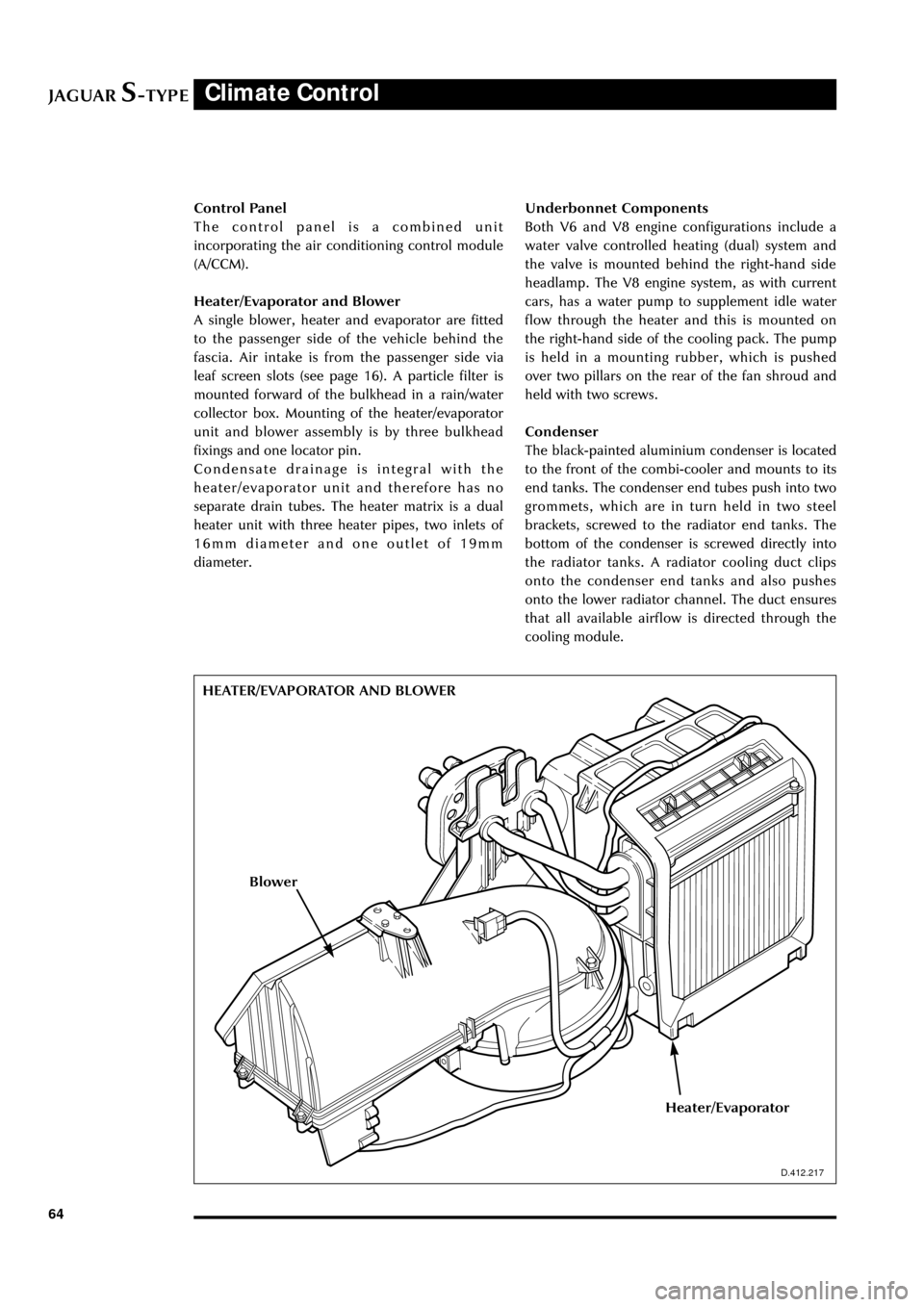
JAGUARS-TYPEClimate Control
64Control Panel
The control panel is a combined unit
incorporating the air conditioning control module
(A/CCM).
Heater/Evaporator and Blower
A single blower, heater and evaporator are fitted
to the passenger side of the vehicle behind the
fascia. Air intake is from the passenger side via
leaf screen slots (see page 16). A particle filter is
mounted forward of the bulkhead in a rain/water
collector box. Mounting of the heater/evaporator
unit and blower assembly is by three bulkhead
fixings and one locator pin.
Condensate drainage is integral with the
heater/evaporator unit and therefore has no
separate drain tubes. The heater matrix is a dual
heater unit with three heater pipes, two inlets of
16mm diameter and one outlet of 19mm
diameter.
D.412.217
Underbonnet Components
Both V6 and V8 engine configurations include a
water valve controlled heating (dual) system and
the valve is mounted behind the right-hand side
headlamp. The V8 engine system, as with current
cars, has a water pump to supplement idle water
flow through the heater and this is mounted on
the right-hand side of the cooling pack. The pump
is held in a mounting rubber, which is pushed
over two pillars on the rear of the fan shroud and
held with two screws.
Condenser
The black-painted aluminium condenser is located
to the front of the combi-cooler and mounts to its
end tanks. The condenser end tubes push into two
grommets, which are in turn held in two steel
brackets, screwed to the radiator end tanks. The
bottom of the condenser is screwed directly into
the radiator tanks. A radiator cooling duct clips
onto the condenser end tanks and also pushes
onto the lower radiator channel. The duct ensures
that all available airflow is directed through the
cooling module.
HEATER/EVAPORATOR AND BLOWER
Blower
Heater/Evaporator